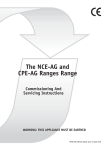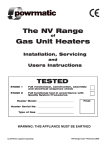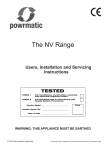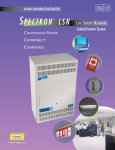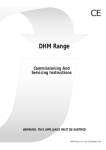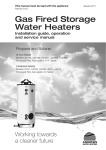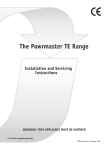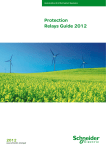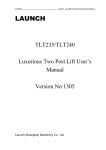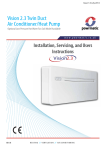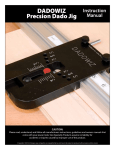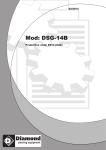Download PGUH Service Manual - May 1995Version
Transcript
CONTENTS Section Title Page 1. 2. 3. 4. 5. 6. 7. 8. 2 3 8 9 11 11 14 9. 10. Introduction Technical Data General Requirements Installation Air Distribution System Commissioning & Testing Servicing Connections to Powrmatic External Controls Fault Finding Short List of Parts Tables Title Page 1a. 1b. 2a. 2b. 3.1 4 4 5 5 4. 5. Dimensions (S.I. Units) Dimensions (Imperial Units) Specifications (S.I. Units) Specifications (Imperial Units) Injector Sizes & Burner Pressures Natural Gas - Group H - G20 Injector Sizes & Burner Pressures Natural Gas - Group L - G25 Injector Sizes & Burner Pressures Propane - G31 Electrical Loadings 1ph Damper Settings PGUH 'C' Units Figure Title Page 1a. 1b. 2. 3a. 3b. 4. 5. Controls Location PGUH 40 Controls Location PGUH 50 - 470 Pilot Flame Adjustment SIT Nova 820 Honeywell V4605C High/Lo and Modulating Heads Cross Lighting Assembly Detail PGUH 50 - 470 12 12 12 13 13 14 3.2 3.3 1 17 18 19 6 6 6 7 7 15 1. INTRODUCTION The Powrmatic PGUH range of gas fired natural draught, open flued, fanned circulation air heaters cover a heat output range of 11.7kW (40000 Btu/h) to 137.7kW (470000 Btu/h). They are certified for us on Natural Gas, Group H - G20 and Group L - G25, and Propane - G31 The heaters are designed to be suspended from suitable roof points or alternatively to be mounted on purpose designed brackets and are intended primarily for heating commercial or industry premises. PGUH-F heaters have an axial fan assembly fitted at the rear to circulate the air being heated through the clam-shell heat exchanger. A centrifugal fan variation is presented in the PGUH-C range for use with ducted systems and the PGUH-D range, in having no fan fitted, is for ducted systems where the air moving fan is by others. Heaters are fitted as standard with atmospheric bar burners, a low energy permanent pilot ignited by a piezo spark generator, a multifuncional control for gas supply control and safety functions, a fan thermostat and limit thermostat. Options include automatic ignition by a full sequence control with low level reset, High/Low or modulating burner controls, inlet duct connection/fan silencer, outlet duct connection, 45° head, 90° outlet bend, nozzle outlet vertical/horizontal outlet louvre assembly and inlet gas manifold for PGUH 270 - 470 units. Each air heater must be connected to an individual open flue system only. The draught diverter is integral with the heater. Gas Safety (Installation & Use) Regulations 1994 It is law that all gas appliances are installed, adjusted and, if necessary, converted by qualified persons* in accordance with the above regulations. Failure to install appliances correctly can lead to prosecution. It is in your own interests and that of safety to ensure that the law is complied with. * e.g. Corgi Registered 2 2 Technical Data PGUH 40 'F' Version Shown B C D F E A Front View Side View G B D F PGUH 50 - 100 'F' Version Shown C E A Front View Side View G PGUH 115 - 240 'C' Version Shown B C D F E A H G J Front View Side View 3 F F K K PGUH 270 - 390 'F' Version Shown Front View Front View PGUH 470 'F' Version Shown Notes:1) Gas connections size for all units R¾". PGUH 40 A B C D E F 700 480 450 320 390 125 517 150 PGUH 50 PGUH 75 Table 1a Dimensions (S.I Units) Note: G #1 refers to 'F' units. G #2 refers to 'C' units. PGUH 85 570 782 PGUH 115 PGUH 200 1023 PGUH 330 932 765 880 PGUH 470 1524 1460 1820 1770 B C D E F 18.9 17.7 12.6 15.3 5.0 20.3 6.0 N/A 786 1378 1598 1760 1808 G #1 G #2 21.1 32.2 H J K 14.2 13.7 25.6 35.4 22.45 30.8 25.2 47.5 26.0 28.6 PGUH 140 25.0 N/A 33.7 PGUH 170 8.0 PGUH 200 40.3 36.7 30.1 34.6 60 57.5 71.7 69.7 PGUH 390 4 16.4 35.8 28.0 PGUH 270 PGUH 470 1257 910 A PGUH 115 PGUH 330 636 855 27.5 PGUH 100 PGUH 240 K 1207 250 PGUH 50 Note: G #1 refers to 'F' units. G #2 refers to 'C' units. J 347 418 910 711 PGUH 390 PGUH 85 640 200 PGUH 270 Table 1b Dimensions (Imperial Units) H 360 855 PGUH 170 PGUH 75 818 660 728 PGUH 140 PGUH 40 535 650 900 PGUH 100 PGUH 240 G #1 G #2 33.7 10.0 35.8 49.5 30.9 54.2 62.9 70.4 71.2 Table 2a - Specifications (S.I. Units) HIGH FIRE MODEL INPUT (Nett) OUTPUT LOW FIRE INPUT (Nett) kw PGUH 40 PGUH 50 PGUH 75 PGUH 85 PGUH 100 PGUH 115 PGUH 140 PGUH 170 PGUH 200 PGUH 240 PGUH 270 PGUH 330 PGUH 390 PGUH 470 F C F C F C F C F C F C F C F C F C F C F C F C F C F C AIR VOLUME OUTPUT Standard kw 13.20 12.0 High 7.90 7.03 0.2486 0.3375 10.29 8.80 0.3108 0.4219 24.85 22.0 15.34 13.19 0.4663 0.6327 28.26 24.9 17.30 14.95 0.5283 0.7172 32.77 29.3 20.11 17.58 0.6216 0.8438 37.87 33.7 23.43 20.22 0.7152 0.9706 54.42 49.8 64.04 58.6 27.94 33.77 39.74 24.62 29.89 35.17 0.8705 1.1813 1.0569 1.4347 1.2436 1.6877 79.0 70.3 48.50 42.20 1.4925 2.0255 87.88 79.1 53.89 47.48 1.741 2.3626 106.9 124.9 156.4 96.7 114.3 137.7 66.55 78.37 100.8 58.03 68.58 82.65 2.1138 2.8694 2.4872 3.3754 2.985 High FAN MOTOR Standard pa 14.6 41.0 Standard m³/s 16.58 45.5 MAXIMUM DUCT RESISTANCE 4.0510 High WEIGHT kg kw N/A N/A 0.03 0.08 50 100 125 0.335 0.55 56 N/A N/A 0.03 0.04 98 204 190 0.335 0.55 110 N/A N/A 0.04 0.10 98 166 150 0.335 0.55 110 N/A N/A 0.04 0.10 98 162 130 0.335 0.55 110 N/A N/A 0.10 0.10 98 139 100 0.335 0.55 110 N/A N/A 0.10 0.37 134 218 150 0.56 0.75 155 N/A N/A 0.10 0.37 134 212 155 0.56 1.1 155 N/A N/A 0.12 0.41 134 145 165 0.56 1.5 155 N/A N/A 0.37 0.5 134 74 200 0.99 1.5 155 N/A N/A 0.37 0.5 153 120 40 0.75 1.5 185.3 N/A N/A 2 x 0.10 2 x 0.37 268 212 155 2 x 0.560 2 x 1.1 310 N/A N/A 2 x 0.12 2 x 0.41 268 145 165 2 x 0.990 2 x 1.5 310 N/A N/A 2 x 0.37 2 x 0.50 268 74 200 2 x 0.990 2 x 1.5 310 N/A N/A 2 x 0.37 2 x 0.50 310 120 40 2 x 0.750 2 x 1.5 374 Table 2b - Specifications (Imperial Units) HIGH FIRE MODEL INPUT INPUT OUPUT OUPUT (GROSS) (GROSS) Btu/h PGUH 40 PGUH 50 PGUH 75 PGUH 85 PGUH 100 PGUH 115 PGUH 140 PGUH 170 PGUH 200 PGUH 240 PGUH270 PGUH 330 PGUH 390 PGUH 470 LOW FIRE F C F C F C F C F C F C F C F C F C F C F C F C F C F C 50043 62856 94209 107137 124235 143569 172495 206312 242783 299422 333163 404800 473548 592930 40000 50000 75000 85000 100000 115000 140000 170000 200000 240000 270000 330000 390000 470000 AIR VOLUME Standard Btu/h 29950 39011 58156 65586 36239 88826 105924 128026 150659 183869 204303 252298 297109 382144 High MAXIMUM DUCT RESISTANCE Standard ft³/m 24000 30000 45000 51000 60000 69000 84000 102000 120000 144000 162000 198000 234000 282000 5 527 659 988 1120 1317 1515 1845 2240 2635 3162 3690 4480 5270 6324 High FAN MOTOR Standard in.wg 715 894 1341 1520 1788 2056 2503 3040 3576 4292 5006 6080 7152 8584 High WEIGHT lbs hp N/A N/A 0.04 0.16 110 0.40 0.50 0.5 0.7 123 N/A N/A 0.04 0.16 216 0.82 0.76 0.5 0.7 243 N/A N/A 0.05 0.16 216 0.67 0.6 0.5 0.7 243 N/A N/A 0.05 0.16 216 0.65 0.52 0.5 0.7 243 N/A N/A 0.13 0.16 216 0.56 0.40 0.5 0.7 243 N/A N/A 0.13 0.88 0.60 0.75 1.0 342 N/A N/A 0.13 0.16 295 0.85 0.62 0.75 1.5 342 N/A N/A 0.16 0.16 295 0.58 0.66 0.75 2.0 243 N/A N/A 0.5 0.55 295 0.30 0.80 1.3 2.0 243 N/A N/A 0.5 0.35 337 0.48 0.16 1.0 2.0 409 N/A N/A 2 x 0.13 2 x 0.16 591 0.85 0.62 2 x 0.75 2 x 1.5 684 N/A N/A 2 x 0.16 2 x 0.16 591 0.58 0.66 2 x 0.75 2 x 2.0 684 N/A N/A 2 x 0.5 2 x 0.55 591 0.30 0.80 2 x 1.3 2 x 2.0 684 N/A N/A 2 x 0.5 2 x 0.35 684 0.48 0.16 2 x 1.0 2 x 2.0 825 295 High Fire Inlet Pressure 20mb MODEL Table 3.1 Injector Sizes & Burner Pressures Natural Gas - Group H G20 Net CV (Hi) = 34.02MJ/m³ Pilot Injector Front Orifice dia 0.38 mm Rear Orifice dia 0.355 mm Pilot Rate 0.1 kW INJECTORS Size mm Marked mbar in.wg m3/h ft3/h mbar in.wg m3/h ft3/h 1.59 159 13.7 5.5 1.40 49.4 4.9 2.0 0.84 26.1 PGUH 50 5 1.51 151 17.5 7 1.75 60.0 7.0 2.8 1.09 38.5 PGUH 75 6 1.70 170 16.1 6.4 2.63 89.7 6.7 2.7 1.62 57.2 PGUH 85 7 1.70 170 14.9 6 2.99 102.2 5.9 2.4 1.83 64.6 PGUH 100 8 1.70 170 15.5 6.2 3.46 118.6 6.0 2.4 2.13 75.2 PGUH 115 5 2.46 246 13 5.2 4.00 139.1 5.0 2.0 2.48 87.6 PGUH 140 6 2.46 246 12.4 5.0 4.81 164.6 4.9 2.0 2.95 104.2 PGUH 170 7 2.46 246 13.5 5.4 5.75 196.3 5.0 2.0 3.57 126.1 PGUH 200 8 2.46 246 14.0 5.6 6.77 231.3 5.5 2.2 4.20 148.3 PGUH 240 10 2.60 260 11.7 4.7 8.35 295.2 4.3 1.7 5.13 181.2 PGUH 270 12 2.46 246 12.2* 4.9* 9.29 311.1 4.6* 1.8* 5.70 201.3 PGUH 330 14 2.46 246 12.8* 5.1* 11.17 391.6 4.9* 2.0* 7.04 248.6 PGUH 390 16 2.46 246 12.6* 5.0* 13.2 466.5 5.1* 2.0* 8.29 292.7 PGUH 470 20 2.60 260 12.1* 4.8* 16.53 568.6 4.2* 1.7* 10.66 376.4 High Fire INJECTORS Burner Pressure Low Fire Gas Rate Burner Pressure Gas Rate No. Size mm Marked mbar in.wg m3/h ft3/h mbar in.wg m3/h ft3/h PGUH 40 4 1.67 167 13.7 5.5 1.62 57.2 5.70 2.3 0.97 34.3 PGUH 50 5 1.70 170 15.6 6.3 2.04 72.0 6.6 2.6 1.27 44.9 PGUH 75 6 1.94 194 14.0 5.6 3.06 108.1 6.4 2.6 1.89 66.7 PGUH 85 7 1.94 194 13.5 5.4 3.48 122.9 6.0 2.4 2.13 75.2 PGUH 100 8 1.94 194 13.3 5.3 4.03 142.3 6.2 2.5 2.47 87.2 PGUH 115 5 2.76 276 11.3 4.5 4.66 164.6 5.5 2.2 2.88 101.7 PGUH 140 6 2.76 276 10.3 4.1 5.6 197.8 5.0 2.0 3.44 121.5 PGUH 170 7 2.61 261 14.0 5.6 6.7 236.6 6.6 2.6 4.16 146.9 PGUH 200 8 2.83 283 11.8 4.7 7.88 278.3 5.7 2.3 4.89 172.7 PGUH 240 10 2.83 283 10.6 4.3 9.72 343.3 5.1 2.0 5.97 210.8 PGUH 270 12 2.76 276 10.6 4.3 10.82 382.1 4.6 1.8 6.63 234.1 PGUH 330 14 2.61 261 13.2 5.3 13.01 459.4 6.0 2.4 8.19 289.2 PGUH 390 16 2.76 276 12.6 5.1 15.37 542.8 5.5 2.2 9.64 340.4 PGUH 470 20 2.76 276 12.1 4.9 19.25 679.8 4.2 1.7 12.41 438.3 MODEL Pilot Injector Front Orifice dia 0.20 mm Rear Orifice dia 0.23 mm Pilot Rate 0.1 kW Gas Rate 4 High Fire Inlet Pressure 37mb Table 3.3 Injector Sizes & Burner Pressures Propane G31 Net CV (Hi) = 88.00MJ/m³ Gas Rate No. MODEL Pilot Injector Front Orifice dia 0.38 mm Rear Orifice dia 0.355 mm Pilot Rate 0.1 kW Low Fire Burner Pressure PGUH 40 Inlet Pressure 25mb Table 3.2 Injector Sizes & Burner Pressures Natural Gas - Group L G25 Net CV (Hi) = 29.25MJ/m³ Burner Pressure INJECTORS Burner Pressure Low Fire Gas Rate Burner Pressure Gas Rate No. Size mm Marked mbar in.wg m3/h ft3/h mbar in.wg m3/h ft3/h PGUH 40 4 1.14 114 22.0 8.8 0.54 19.1 6.8 2.7 0.32 11.3 PGUH 50 5 1.14 114 24.0 9.6 0.68 24.0 8.4 3.4 0.42 14.8 PGUH 75 6 1.27 127 25.0 10.0 1.02 36.0 9.0 3.6 0.63 22.3 PGUH 85 7 1.27 127 23.5 9.4 1.16 41.0 8.3 3.3 0.71 25.1 PGUH 100 8 1.27 127 25.0 10.0 1.34 47.3 9.3 3.7 0.82 29.0 PGUH 115 5 1.70 170 22.0 8.8 1.55 54.7 8.2 3.3 0.96 33.9 PGUH 140 6 1.70 170 22.2 8.9 1.86 65.7 7.6 3.0 1.14 40.3 PGUH 170 7 1.75 175 20.0 8.0 2.24 79.1 6.7 2.7 1.38 48.7 PGUH 200 8 1.75 175 22.0 8.8 2.62 92.5 7.0 2.8 1.63 57.6 PGUH 240 10 1.75 175 19.5 7.8 3.23 114.1 6.8 2.7 1.98 69.9 PGUH 270 12 1.70 170 20.7* 8.3* 3.59 126.8 7.7* 3.1* 2.20 77.7 PGUH 330 14 1.75 175 19.6* 7.8* 4.32 152.6 7.2* 2.9* 2.72 96.1 PGUH 390 16 1.75 175 21.2* 8.5* 5.14 181.5 7.5* 3.0* 3.21 113.4 PGUH 470 20 1.75 175 20.0* 8.0* 6.40 226.0 7.9* 3.2* 4.12 145.5 6 Standard Airflow MOTOR PLATE AMPS (A) MODEL R.P.M. PGUH 40F 0.35 PGUH 50F PGUH 75F 0.53 PGUH 85F PGUH 100F PGUH 115F 0.87 PGUH 200F Note: 3ph Data is supplied seperately with units ordered to this specification. 3.00 PGUH 240F 0.46 0.28 1500 1.37 1.6 0.53 0.53 0.45 0.35 0.26 0.68 0.49 2 x 1000 1.80 4.7 2.20 8.9 2.70 5.2 3.87 8.5 3.90 2 x 1000 2 x 3.00 9.4 4.40 2.60 PGUH 75C 3.00 1500 7 2 x 1500 2.60 5 4.10 4.80 2.10 9.80 3.20 5.20 3 PGUH 200C 7.40 PGUH 240C 5 2 x 4.10 2 x 1000 2 x 7.40 3 5 7 10.4 7.74 10 17.0 7.80 5.40 3.60 21.0 4.50 5 22.0 4.60 5.40 19.0 4.12 7.40 32.0 6.40 1500 13.0 5.50 37.0 6.60 2 23.0 4.70 11.0 3.80 PGUH 170C 1 21.0 4.50 10.0 3.00 PGUH 140C PGUH 470C 2 x 4.00 5.80 2.40 1000 PGUH 270C 4.00 2 2 x 2.57 17.8 5.40 11.00 5.00 5.20 2.20 PGUH 85C 1.20 2.57 5 5.40 3.60 PGUH 390C 1.30 5.4 2 12.20 3.90 2.80 1.80 PGUH 330C 1.4 6.10 1.95 PGUH 50C PGUH 115C 0.98 1.80 1.33 PGUH 40C PGUH 100C 0.81 1000 3 1.33 1.3 1.35 1.00 5.50 2.50 START RUN FUSE AMPS AMPS RATING( (A) (A) (A) 1.3 2 x 1.00 3.60 2.70 2 x 3.00 PGUH 470F 1 0.66 0.61 2 x 0.87 3.20 2.20 PGUH 270F PGUH 390F R.P.M. PLATE AMPS (A) 1.60 1.10 1.00 PGUH 170F PGUH 330F MOTOR 1.50 0.80 1000 PGUH 140F Table 4 Electrical Loadings 1ph High AirFlow START RUN FUSE AMPS AMPS RATING (A) (A) (A) 7 32.0 8.60 9.50 7 36.0 7.50 10 36.0 9.20 20.0 6.50 7.40 22.0 7.00 10 26.0 11.0 13 74.0 13.0 15 64.0 12.80 13 64.0 17.20 9.50 72.0 15.00 20 72.0 18.40 Distance of Damper Plate from Fan Casing (mm) MODEL PGUH 40C PGUH 50C PGUH 75C PGUH 85C PGUH 100C Table 5 Damper Settings PGUH 'C' Units Standard Airflow PGUH 115C PGUH 140C PGUH 170C PGUH 200C PGUH 240C PGUH 270C PGUH 330C PGUH 390C PGUH 470C DESIGN AIRFLOW 20 30 40 50 60 70 80 DUCT RESISTANC 527 ft³/m 0.32 0.39 0.46 0.48 0.54 0.60 0.2486 m³/s 80 98 115 120 135 150 Pa 659 ft³/m 0.55 0.67 0.72 0.76 0.79 0.82 ins.w.g 0.3108 m³/s 138 168 180 190 198 204 Pa 968 ft³/m 0.44 0.55 0.59 0.61 0.63 0.67 ins.w.g 0.4663 m³/s 110 136 146 152 158 166 Pa 1120 ft³/m 0.39 0.50 0.56 0.59 0.64 0.65 ins.w.g 0.5283 m³/s 98 124 140 148 160 162 Pa 1317 ft³/m 0.27 0.39 0.47 0.50 0.55 0.56 ins.w.g 0.6216 m³/s 68 98 116 124 136 139 Pa 1515 ft³/m 0.66 0.73 0.79 0.84 0.86 0.88 ins.w.g 0.7152 m³/s 164 183 198 208 214 218 Pa 1845 ft³/m 0.55 0.63 0.71 0.78 0.81 0.85 ins.w.g 0.8705 m³/s 136 158 176 194 202 212 Pa 2240 ft³/m 0.16 0.34 0.43 0.49 0.56 0.58 ins.w.g 1.0569 m³/s 40 84 108 122 140 145 2635 ft³/m 0.09 0.18 0.24 0.30 0.31 1.2436 m³/s 22 44 61 74 78 3162 ft³/m 1.4925 m³/s 3690 ft³/m 1.741 m³/s 2 x 136 4480 ft³/m 2 x 0.16 2 x 0.34 2 x 0.43 2 x 0.49 2 x 0.56 2 x 0.58 2.1138 m³/s 5270 ft³/m 2.4872 m³/s 6324 ft³/m ins.w.g 2.985 m³/s Pa 7 ins.w.g Pa ins.wg Pa ins.w.g Pa 2 x 0.55 2 x 0.63 2 x 0.71 2 x 0.78 2 x 0.81 2 x 0.85 2 x 40 2 x 158 2 x 84 2 x 176 2 x 108 2 x 194 2 x 122 2 x 202 2 x 140 ins.w.g 2 x 212 Pa ins.w.g 2 x 145 Pa 2 x 0.09 2 x 0.18 2 x 0.24 2 x 0.30 2 x 0.31 2 x 22 2 x 44 2 x 61 2 x 74 2 x 78 ins.w.g Pa 3.3.2 Meters 3. General Requirements A gas meter is connected to the service pipe by the local gas undertaking or a local gas undertaking contractor. An existing meter should be checked, preferably by the gas undertaking, to ensure that the meter is adequate to deal with the total rate of gas supply required. 3.1 Related Documents The installation of the air heater(s) must be in accordance with the rules in force and the relevant requirements of the Gas Safety Regulations, Building Regulations and the I.E.E. Regulations for Electrical Installations. It should be in accordance also with any relevant requirements of the local gas region, local authority and fire authority and the relevant recommendations of the following documents. 3.3.3. Installation Pipes Installation pipes should be fitted in accordance with IM/16:1988. Pipework from the meter to the air heater must be of adequate size. Do not use pipes of a smaller size than the inlet gas connection of the heater. The complete installation must be tested for soundness as described in the above Code. The complete installation must be tested for soundness as described in BS 6230. British Gas Plc Publications IM/11 : 1989 Flues for Commercial and Industrial Gas Fired Boilers and Air Heaters IM/16 : 1988 Guidance notes for the installation of gas pipework, boosters and compressors in Customer’s premises (excluding domestic installation of 25mm and below). 3.3.4. Boosted Supplies Where it is necessary to employ a gas pressure booster the controls must include a low pressure cut off switch at the booster inlet. The local gas undertaking must be consulted before a gas pressure booster is fitted. The maximum inlet pressure is 60mb. British Standards Code of Practice BS 5588 Fire precautions in the design and construction of buildings. Part 2 : 1985 Code of Practice for Shops Part 3 : 1983 Code of Practice for Office Buildings BS 6230:1991 Installation of Gas Fired Forced Convection Air Heaters for Commercial and Industrial Space Heating. 3.4 Flue System Detailed recommendations for fluing are given in BS 5440, Part 1 (Flues) and IM/11. Those appliances having an input rating not exceeding 60kW viz. PGUH 40 to PGUH 140 inclusive must be installed in accordance with the relevant recommendations of the following documents. BS 5440 Flues and Air Supply for gas appliances of rated input not exceeding 60kW (1st and 2nd family gases). Part 1 - Flues, Part 2 - Air Supply The air heater is fitted with an integral draught diverter and must be connected to an individual flue system only. The cross sectional area of the flue serving the appliance must be not less than the area of the flue outlet to the air heater. Materials used for the flue system should be mechanically robust, resistant to internal and external corrosion, noncombustible and durable under the conditions to which they are likely to be subjected. Prevention of condensation within the flue should be an important factor in the design of the flue system. In order to minimise condensation the use of double walled flue pipe or insulation is recommended. If double walled flue pipe is used it should be of a type acceptable to British Gas. Where condensation in the flue is unavoidable provision should be made for condensation to flow freely to a point at which it can be released, preferably into a gully. The condensation pipe from the flue to the disposal point should be of non-corrodible material of not less than 22mm (1/2") size. Facilities should be made for disconnecting the flue pipe(s) from the air heater(s) for inspection and servicing purposes. Bends with removable covers should be fitted for inspection and cleaning purposes where considered appropriate. The flue should terminate in a freely exposed position and must be so situated as to prevent the products of combustion entering any opening in a building in such concentration as to be prejudicial to health or a nuisance. It is recommended that consideration be given to the fitting of a terminal at the flue outlet, however, where the heater flue is less than 200mm (8") in diameter a terminal of a type that has been tested and found satisfactory by British Gas must be fitted. For PGUH - D appliances of 40 - 140 size, reference should also be made to BS 5864. Code of Practice for installation of gasfired ducted-air heaters of rated input not exceeding 60kW. 3.2 Location The location chosen for the air heater must permit the provision of a satisfactory flue system and an adequate air supply. The location must also provide adequate space for servicing and air circulation around the air heater. The heater(s) must not be installed in conditions for which it is not specifically designed e.g. where the atmosphere is corrosive or salty and where high wind speeds may affect burner operation, and they are not suitable for outdoor use. Where the location of the air heater is such that it might suffer external mechanical damage e.g. from overhead cranes, fork lift trucks, it must be suitably protected. PGUH units are designed to operate in a maximum ambient temperature of 25 °C. 3.3 Gas Supply 3.3.1 Service Pipes The local gas undertaking should be consulted at the installation planning stage in order to establish the availability of an adequate supply of gas. An existing service pipe must not be used without prior consultation with the local gas undertaking. 3.5 Air Supply In buildings having a design air change rate of less than 0.5 /h, and where PGUH units are to be installed in heated spaces having a volume less than 4.7 m3 /kW of total rated heat 8 input grilles shall be provide at low level as follows:(1) for heaters of heat input less than 60 kW, the total minimum free area shall not be less than 4.5 cm2 per kilowatt of rated heat input. (2) for heaters of heat input 60 kW or more, the total minimum free area shall not be less than 270cm2 plus 2.25 cm2 per kilowatt in excess of 60 kW rated heat input. The air vent(s) should have negligible resistance and must not be sited in any position where it is likely to be easily blocked or flooded or in any position adjacent to an extraction system which is carrying flammable vapour. environment and the air temperatures which will result when the overheat limit thermostat is being commissioned. Where inter-joist spaces are used as duct routes they should be suitably lined with a fire-resisting material. A full and unobstructed return air path to the air heater(s) must be provided. If the air heater(s) is installed in a plant room the return air intake(s) and the warm air outlet(s) from the heater(s) must be fully ducted, in to and out of the plant room to avoid interference with the operation of the flue by the air circulation fan. The openings in the structure of the plant room through which the ducting passes must be fire stopped. Care must be taken to ensure that return-air intakes are kept clear of sources of smells and fumes, and in special circumstances where there is any possibility of pollution of the air by dust, shavings etc., precautions must be taken by carefully positioning return air intakes and by the provision of screens to prevent contamination. In addition, where there is a risk of combustible material being placed close to the warm air outlets, suitable barrier rails should be provided to prevent any combustible material being within 900mm (3ft) of the outlets. Where the air heater(s) will be installed in a plant room the latter must have permanent air vents at high level and at low level communicating directly with the outside air. Where communication with the outside air is possible only by means of high level air vents, ducting down to floor level for the lower vents should be used. Air vents should have negligible resistance and must not be sited in any position where they are likely to be easily blocked or flooded or in any position adjacent to an extraction system which is carrying flammable vapour. Grilles or louvres should be so designed that high velocity air streams do not occur within the plant room. 3.7 Electrical Supply Wiring external to the air heater must be installed in accordance with the I.E.E. Regulations for Electrical Installations and any local regulations which apply. Wiring should be completed in flexible conduit. All standard heaters are supplied by 230V - 1ph, 50Hz. The method of connection to the main electricity supply must facilitate the complete electrical isolation of the air heater(s) and the supply should serve only the air heater(s). It must have a contact separation of at least 3mm in all poles. The method of connection should be provided adjacent to the air heater(s) in a readily accessible position. See the accompanying wiring diagram for the heater electrical connections PGUH units can also be supplied for 400V 3N, 50Hz The basic minimum effective area requirements of the air vents are as follows: (a) Low Level (inlet) (1) for heaters of total rated heat input less than 60 kW: 9 cm2 per kilowatt of rated heat input (2) for heaters of total rated heat input 60 kW or more: 540 cm2 plus 4.5 cm2 per kilowatt in excess of 60 kW total rated input. (b) High Level (outlet) (1) for heaters of total rated heat input less than 60 kW: 4.5 cm 2 per kilowatt of rated heat input; (2) for heaters of total rated heat input 60 kW or more: 270 cm2 plus 2.25 cm2 per kilowatt in excess of 60kW total rated input. 4. Installation of Air Heater(s) 3.6 Air Distribution System 4.1 General The following notes are of particular importance. For free-blowing units it must be taken into account that the buoyancy of the heated air leaving the heater and air patterns within the space being heated will modify the air throw pattern achieved. In buildings having a low heat loss where single units are required to cover a large floor area and in buildings with high roof or ceiling heights Calecon thermal economiser units should be fitted to ensure even heat distribution and minimise stratification respectively. Care should be taken to avoid impeding the air throw with racking, partitions, plant or machinery etc. Various outlet configurations are available as optional extras to modify the air throw pattern to suit particular site conditions. Before installation, check that the local distribution conditions, nature of gas and pressure, and adjustment of the appliance are compatible. The air heater must be installed in accordance with the rules in force and the relevant requirements of any fire regulations or insurance company’s requirements appertaining to the area in which the heater is located, particularly where special risks are involved such as areas where petrol vehicles are housed, where cellulose spraying is carried out, in wood working departments etc. Whichever method of mounting the air heater is used the following minimum clearances for installation and servicing must be observed. RHS Clearance (looking at front of heater) 0.5m (1.6ft) LHS Clearance (looking at front of heater) 0.75m (2.4ft) Top of the heater to ceiling 0.6m (2.0ft) Rear of heater to nearest wall 0.6m (2.0ft) For multi air heater installations the following minimum distances between units must be observed. For ducted units all delivery and return air ducts, including air filters, jointing and any insulation or lining must be constructed entirely of materials which will not contribute to a fire, are of adequate strength and dimensionally stable for the maximum internal and external temperatures to which they are to be exposed during commissioning and normal operation. In the selection of materials account must be taken of the working 9 Between units, side to side Between units, back to back 3.0m (9.9ft) 3.0m (9.9ft) individual flue outlets and provide a single flue outlet and this must be fitted. The flue system connects directly on to the manifold. For flue sizes refer to Tables 1a and 1b Page 4 . All units must be fitted with a flue having a minimum height, from the heater or flue manifold socket to the flue terminal, of 2m (6.5ft). Horizontal runs of flue are not permitted. If necessary a single offset using two 45° bends can be included to avoid obstructions. Mounting heights Floor to underside of heater Model 40F 50F - 100F Recommended Minimum 2.0m (6.5ft) - 2.5m (8.2ft) 1.8m (5.9ft) 2.5m (8.2ft) - 3.0m (9.8ft) 2.5m (8.2ft) 4.4 Condensate Drainage 115F - 470F 3.0m (9.8ft) - 5.0m (16.4ft) 2.5m (8.2ft) 'C' & 'D' Not applicable The design of the flue system should minimise the formation of condensation, however when this is envisaged to be a problem provision should be made for condensation to flow to a joint where it can be drained, preferably into a gully. As above All models Any combustible material adjacent to the air heater and the flue system must be so placed or shielded as to ensure that its temperature does not exceed 65 °C (150 °F) IMPORTANT: 1. To facilitate removal of the burner tray there must be no projection or fixture in front of the lower front panel. The distance forward of the air heater in which this is applicable is the same as the front to back dimension of the heater. 2. No air heater shall be installed where there is a foreseeable risk of flammable particles, gases vapours or corrosion inducing gases or vapours being drawn into either the heated air stream or the air for combustion. In such cases installation may only proceed if the air to be heated and the air for combustion are ducted to the heater from an uncontaminated source preferably outside the building. In certain situations where only airborne particles are present it may suffice to fit filters on the air inlet ducts of the heater. Advice in these instances may be obtained from Powrmatic Ltd. 4.5 Gas Connection To facilitate removal of the burner tray for servicing purposes a servicing valve and downstream union must be fitted at the inlet to the air heater. The gas supply to the air heater must be completed in solid pipework and be adequately supported. Heaters suspended by drop rods or chains must have a flexible connection as the final link between the gas supply pipework and the heater. Sufficient slack must be left in the connection to take account of normal movement of the heater. On models PGUH 270 - 470 the two individual gas inlets must be manifolded together . A union connection must be provided at the gas inlet to each gas control assembly. WARNING When completing the final gas connection to the heater do not place undue strain on the gas pipework of the heater. 4.6 Electrical Connections All units are fully pre-wired and only require final connections for the incoming mains supply and completion of the control circuit (230V) via a room thermostat, time clock etc. The electrical supply must be run to a point adjacent to the heater and be suitably terminated to provide an isolation point that will prevent remote activation of the unit during servicing. Reference must be made to Table 4 (Page 7) to ascertain the electrical loading of the air heater(s) being installed so that cables of adequate cross-sectional area to safely carry that load are used for the electrical installation. The length of the conductors between the cord anchorage and the terminals must be such that the current carrying conductors become taut before the earth conductor if the cable or cord slips out of the cord anchorage. All external controls must be of an approved type. See the wiring diagram accompanying these instructions. When installing PGUH ‘D’ models they must be electrically interlocked to the air movement system so that this is started in the same manner as the air heater fan would be. A connection from heater terminal No 9 must be made to one side of the fan motor contactor coil, the other side of the coil being connected to Neutral. Under no circumstances must the fan motor electrical supply be taken direct from the internal wiring of the PGUH. 4.2 Fitting the Air Heater The air heater may be installed either: a) suspended by suitable drop rods, chains or straps. b) on specifically designed cantilever brackets from a noncombustible wall. c) on a level noncombustible surface providing the surface does not extend past the front edge of the heater Whatever method of installation is used it must be capable of adequately supporting the weight of the unit (See Tables 2a and 2b, Page 5) and allowance must be made for any ancillary equipment. Before installing the heater any existing trusses, walls, brackets etc., must be inspected to ensure they are suitable. All supports should be protected against the effects of rust or corrosion. If noise levels are of particular importance the heater should be insulated from the structure of the building by installing it on suitable anti-vibration mountings. In all such cases and, in addition, when the heater is suspended it is essential that all gas, duct, electrical and flue connections to the heater are made with flexible connections to maintain continuity of connection. In the case of the flue connection single wall stainless steel flue is deemed to flex sufficiently to meet the requirements. 4.3 Connection of Air Heater(s) to Flue System 5. Air Distribution System All models are fitted with an integral down draught diverter. For models PGUH 40 - 240 the flue system connects directly into the flue socket on the top of the unit. Models PGUH 270 - 470 are supplied with a flue manifold to join together the 5.1 General PGUH 'C' and 'D' models are designed for use with duct work to more precisely define the point of air delivery, and /or 10 provide ducted return air or ducted fresh air inlet. If inlet ductwork is used heaters must be ordered with fan inlet sections in order to maintain service access to the centrifugal fan(s). All ducting must be independently supported of the air heater. Joints and seams of supply ducts and fittings must be securely fastened and made airtight. a) Ensure that the ELECTRICAL supply to the heater is switched OFF. b) Check that all warm air delivery outlets are open. c) Check that the thermostat is set at MAX. d) Check that the clock control is set to an ON period. e) Check that any other controls are calling for heat. f) Ensure that the Summer/Winter switch is in the Winter position. g) Check that the overheat reset button has not operated. 5.2 Noise Reduction It is recommended that ducting should be connected to the heater spigots via an airtight flexible coupling of noncombustible material. Before fitting coupling it must be ensured that a maximum clearance of 13mm (1/2") will be maintained between the ends of the ducting and the heater spigots. If required sound attenuators may be fitted in inlet and outlet ducts to reduce airborne fan noise. Materials used in outlet sound attenuators must be capable of withstanding 100 °C air temperature without any deterioration. 6.5 Lighting the Air Heater WARNING: The multifunctional gas control(s) is operated by 230 volts. NOTES: 1. When attempting to light the pilots at any time ensure that the mains electricity supply is switched off. 2. On initial lighting of the heater(s), it may take some time to purge the internal pipework of air. IMPORTANT: The internal pipework of the appliance has been tested for soundness before leaving the factory. After establishing the pilot(s) and with the main burners alight test round the gas inlet connection using a leak detection fluid. 5.3 Room Thermostat Siting The room thermostat should be fitted at a point which will be generally representative of the heated area as far as temperature is concerned. Draughty areas, areas subjected to direct heat e.g. from the sun, and areas where the air movement is relatively stagnant e.g. in recesses, are all positions to be avoided for siting the thermostat. The thermostat should be mounted about 1.5m (5ft) from the floor. Any room thermostat, frost thermostat, time clock etc. must be suitable for switching 230V, 0.02A (Standard Units) or 230V, 5A (/AI Units) and must be of the 'snap action' type to minimise contact bounce. For electrical connections of external controls see the accompanying wiring diagram. 6.5.1 Standard Models 6.5.1.3 Models PGUH 40 - 240. (SIT 820 NOVA MFC) 1. Remove the escutcheon plate(s) covering the multifunctional control(s) at the rear of the heater. (Fig.1b - 8). 2. Press the knob of the multifunctional control (Fig.3a - 1) and rotate to Pilot. 3. Light the pilot flame by pressing the piezo unit button (Fig 1a ,1b - 3) several times keeping the multifunctional control knob depressed. The pilot flame may be viewed through the opening in the rear of the unit. 4. Ensure that the pilot flame fully envelopes 9-12mm of the thermocouple tip (See Fig. 2) and, if necessary adjust the pilot regulating screw (Fig.3a - 3) . 5. Once the pilot has been established continue pressing the control knob for approximately 30 seconds and then slowly release. The pilot should remain alight. WARNING: Should the pilot be extinguished at any time, either intentionally or unintentionally, slightly depress the control knob and rotate clockwise to Off. Wait 3 minutes before attempting to relight the gas, then repeat steps 3-5 above. 6. Commissioning & Testing 6.1 Electrical Installation Checks to ensure electrical safety must be carried out by a qualified person. 6.2 Gas Installation The whole of the gas installation, including the meter, should be inspected and tested for soundness and purged in accordance with the recommendations of IM/16:1988. 6.3 Air Distribution System The system should be checked to ensure that the installation work has been carried out in accordance with the design requirements. Particular attention should be given to the correct arrangement of delivery ducts and registers, return air ducts and grills and general adequacy of return air paths. For PGUH 'C' standard airflow units refer to Table 5 (Page7) to ascertain the fan damper setting to match the resistance of the ductwork. PGUH 'C' high airflow units are matched to the duct resistance detailed in Tables 2a and 2b (Page5) and the ductwork balanced accordingly. 6. Slightly depress the control knob and turn to On. 7. Switch on the electricity supply at the isolator, and the main burners will light. 8. SHUT OFF To interrupt all gas flow through the multifunctional control slightly depress the control knob and rotate clockwise to Off. CAUTION The restart interlock device prevents the heater from re-igniting until the flame supervision device has interrupted the gas flow. After waiting 3 minutes the heater may be relit by following the previous instructions from 6.5. 6.4 Checks before lighting the Air Heater The following preliminary checks should be made before lighting the heater(s) 11 8 Fig. 1a Controls Location PGUH 40 7 6 Viewed from rear of unit 5 Pilot tube, thermocouple and thermocouple interrupter leads not shown for clarity 1) 2) 3) 4) 5) 6) 7) 8) SIT 820 Nova M.F.C. Gas connection (Rp½). Piezo spark generator. Viewing port. Cable entry points. Summer / Winter switch. Limit Thermostat reset button. Side panel (For access to electical section). P IL E 3 OT A 2 1 4 9 - 12 mm Fig.2 Pilot Flame Adjustment Fig. 1b Controls Location PGUH 50 - 470 9 10 Viewed from rear of unit Note: PGUH 270 - 470 units have a M.F.C. Fan and limit thermostats, and an access panel also on the left hand side of the unit. 1) 2) 3) 4) 5) 6) 7) 8) 9) 10) SIT 820 Nova M.F.C. Gas connection (Rc¾). Piezo spark generator Viewing port. Cable entry points. Summer / Winter switch. (Two on PGUH 270 - 470 units) Limit Thermostat reset button. Escutcheon plates. Electrical section cover panel. Electrical section. 2 1 4 8 7 3 12 5 6 6.5.1.2 Models PGUH 270 - 470. (SIT 820 NOVA MFC) 2. If the burners fail to light the control box will go to lockout and the lockout light on the low level remote reset will be illuminated. To restart the ignition sequence depress the reset button on the low level reset. 3. SHUT OFF Set the clock control to OFF or set the room thermostat to MIN. 1. Follow steps 6.5.1.1.1 to 6.5.1.1.5 and establish the right hand pilot. 2. Follow steps 6.5.1.1.1 to 6.5.1.1.5 and establish the left hand pilot. 3. Switch on the electricity supply at the isolator and the main burners will light. 4. SHUT OFF To interrupt all gas flow through the multifunctional controls slightly depress the control knob and rotate clockwise to Off. CAUTION The restart interlock device prevents the heater from re-igniting until the flame supervision device has interrupted the gas flow. After waiting 3 minutes the heater may be relit by following the previous instructions from 6.5. 6.6 Adjustments 6.6.1 Burner Gas Pressure This is set for the required heat input before despatch. In the case of Hi/Lo and Modulating units both high and low pressures are set. Pressures should be checked in the following manner. For models PGUH 270-470 inc. follow the instructions below for both sets of burners whilst both sets are alight. 6.5.2. Auto Ignition Units 6.5.2.1 All Models 6.6.1.1 Standard & Auto Ignition Units 1. Set external controls to ensure that the main burner is off. If necessary remove the escutcheon plate(s) covering the multifunctional control(s) at the rear of the heater (Fig. 1b - 8). Connect a pressure gauge to the outlet pressure testpoint on the multifunctional control (PGUH 40) or the burner pressure test point, to the left of the multifunctional control, that extends from the injector manifold (PGUH 50 - 470). 2. Set external controls so as to turn on the main burner. 1. Switch on the electrical supply at the isolator and the ignition sequence will commence. After a delay of approximately 30 seconds the ignition spark will be generated and the main gas valves energized. The burners will then light. Note: On PGUH 270 - 470 units the left hand (viewed from the front) burner set will light first. Only when this burner set is lit will the right hand burner set begin its ignition sequence. 4a 4 1 Fig. 3a - SIT 820 Nova 1. 2. 3. 4. 4a. 5. 6. 7. 8. 2 3 PIL Control Knob. Pressure Regulator cap screw. Pilot gas rate adjuster. Thermocouple connection. Thermocouple interrupter connections. Pilot connection. Inlet pressure test point. Outlet pressure test point. Electrical connections for main valve operator. E 6 A 7 8 1 4 5 OT 3 Fig. 3b - Honeywell V4605C 1. 2. 3. 4. 5. Governor adjustment cover screw. Electrical connections for main valve operator. Earth connection. Safety shut off valve. Safety shut off valve electrical connections. 2 5 13 and then re check the pressures. 5. Turn off the main burner as in 6.6.1.1. disconnect the pressure gauge and replace the sealing screw. Turn on the main burner as in 6.6.1.2. above and test for gas soundness around pressure test joint using a leak detection fluid e.g. soap solution. Replace escutcheon plates. Compare the measured burner gas pressure to that stated in Section 2. 3. If necessary adjust the burner gas pressure by removing the cover screw (Fig 3a -2, Fig 3b - 1) and turning the regulator screw anticlockwise to decrease the pressure, or clockwise to increase the pressure. 4. In addition it is advisable to check the gas rate using the gas meter dial pointer. Ensure that no other appliances supplied through the meter are in operation. 5. Turn off the main burner as in 6.6.1.1. disconnect the pressure gauge and replace the sealing screw. Turn on the main burner as in 6.6.1.2. above and test for gas soundness around pressure test joint using a leak detection fluid. Replace escutcheon plates. 6.6.2 Down Draught Diverter 1. Check that there is no spillage of products of combustion from the air heater down draught diverter by carrying out a spillage test, as detailed in BS 5440 Part 1. 6.6.3 Air Heater Controls 6.6.3.1 Standard Units 1. Check that the flame failure device will shut off the gas to the main burner within 60 seconds by turning off the gas supply at the gas service valve. A distinct click will be heard when the thermocouple current is no longer sufficient to hold in the magnetic unit. 2. Check that the room thermostat and all automatic controls are operating satisfactorily. 6.6.1.2 High/Lo and Modulating Units 1. Set external controls to ensure that the main burner is off. If necessary remove the escutcheon plate(s) covering the multifunctional control(s) at the rear of the heater (Fig. 1b - 8). Connect a pressure gauge to the outlet pressure testpoint on the multifunctional control (PGUH 40) or the burner pressure test point, to the left of the multifunctional control, that extends from the injector manifold (PGUH 50 - 470). 2. Set external controls so as to turn on the main burner and maintain high fire. Compare the measured burner gas pressure to that stated in Section 2. In addition it is advisable to check the gas rate using the gas meter dial pointer. Ensure that no other appliances supplied through the meter are in operation. 3. Repeat 2 above with external controls set to maintain low fire. 6.7 Handing over the Air Heater Hand the Users Instructions to the user or purchaser for retention and instruct in the efficient and safe operation of the air heater and associated controls. Adjust the automatic controls to those values required by the User. Finally, advise the user or purchaser that, for continued efficient and safe operation of the air heater, it is important that servicing is carried out annually. In the event that the premises are not yet occupied turn off the gas and electricity supplies and leave instructional literature adjacent to gas meter. Fig. 4 High/Lo and Modulating Heads A B C D1 D2 E F Low pressure setting screw Valve stem Valve body Locking spring (Modulating Head) Locking spring (Hi/Low Head) Locknut Spring A D2 B 7. Servicing WARNING: Always switch off and disconnect electricity supply and close the gas service valve before carrying out any servicing work or replacement of failed components. NOTE: 1. The following instructions refer specifically to Models PGUH 40-240. For Models 270-470 inc repeat the instructions so that both sets of components are fully serviced. 2. If a suspended air heater is to be serviced do not lean ladders against the heater. Ensure that an access tower or equivalent is used. C D1 E F 4. If it is necessary to adjust the high pressure setting then proceed from step i). If it is only necessary to adjust the low fire pressure setting proceed from step vii). Refer to Fig.4 i) Set external controls to turn main burner OFF. ii) Pull back the clip retaining the actuator coil to its mounting stem and remove the coil. iii) Set external controls to turn main burner ON. iv) Screw adjustment screw A fully clockwise. v) Release the M13 locknut E that secures the actuator stem into the mfc governor and turn the actuator stem to set the HIGH FIRE pressure (clockwise to increase pressure). vi) Tighten the locknut without further turning the actuator stem. vii) Unscrew adjustment screw A to set the LOW FIRE pressure (anti clockwise to decrease pressure). viii) Set external controls to turn burner OFF and replace valve body C onto the valve stem ensuring that it clips into position 7.1 General Full maintenance should be undertaken not less than once per year by a qualified person. After any servicing work has been completed or any component replaced the air heater(s) must be fully commissioned and tested for soundness as described in Section 6. 7.2 Main Burner Assembly Removal 7.2.1 PGUH 40 1. Ensure that the gas service valve is turned OFF and then unscrew the union nut situated immediately down stream of it. 2. Remove the plug (Fig 3a - 8), or push on connections (Fig 3b - 2 & 5), from the multifunctional valve. 3. On standard units pull off the thermocouple interrupter leads from the interrupter block insert (Fig 3a - 4a). 14 4. Remove the right and left outer panels. 5. Remove the two M5 screws that secure the burner tray in position . 6. Remove the lower front panel and lower rear panels by releasing the two securing screws on each side of each panel. On standard units on the rear lower panel remove the piezo igniter lead from the piezo igniter. 7. Remove the burner tray complete, from the front of the air heater, by pulling forwards. For suspended air heaters it is recommended that the burner assembly is taken down to floor level before proceeding. 8. Release the screws securing the cross lighting strip assembly and remove the assembly. 9. Remove the anti flame roll strip at the injector end of the burner tray. 10. Remove each burner from its injector and using a stiff brush (not wire), brush the flame strips to dislodge accumulated deposits. Inspect the burners both internally and externally to ensure that they are clean. Examine the injectors and if damaged or deteriorated, replace with new ones of the correct size and marking (see Section 2 tables 3.1, 3.2 or 3.2). If deemed necessary, clean the injectors. Do not broach out with wire. NOTE: If a full service is being undertaken then complete sections 7.3 and 7.4 before continuing. 11. Reassemble the injectors, burners anti flame roll strip and cross lighting assembly etc in reverse order to that above. unscrew the union nut situated immediately down stream of it. 2. Remove the escutcheon plates covering the multifunctional control (Fig1b - 8). 3. Remove the plug (Fig 3a - 8), or push on connections (Fig 3b - 2 & 5), from the multifunctional valve. 4. On standard units pull off the thermocouple interrupter leads from the interrupter block insert (Fig 3a - 4a). 5. On standard units disconnect the piezo ignition lead from the bulkhead connector on the rear of the burner tray. 6. Remove the access door to the electrical panel (Fig1b - 9). 7. Remove the lower front panel by releasing the two securing screws. 8. Remove the two M5 screws that secure the burner tray in position. 9. Remove the burner tray complete, from the front of the air heater, by pulling forwards. For suspended air heaters it is recommended that the burner assembly is taken down to floor level before proceeding. 10. Release the nuts securing the cross lighting strip assembly and remove the two strips (see Fig 5, - 1 & 2) 11. Remove each burner by lifting up at the cross lighting strip end and then disengaging from its injector. Using a stiff brush (not wire), brush the flame strips to dislodge accumulated deposits. Inspect the burners both internally and externally to ensure that they are clean. Examine the injectors and if damaged or deteriorated, replace with new ones of the correct size and marking (see Section 2 tables 3.1, 3.2 and 3.3). If deemed necessary, clean the injectors. Do not broach out with wire. NOTE: If a full service is being undertaken then 7.2.2 PGUH 50 - 240 1. Ensure that the gas service valve is turned OFF and then Fig 5 Cross LIghting Assembly Detail PGUH 50 - 470 1 2 2 1 15 complete sections 7.3 and 7.4 before continuing. 12. Reassemble the injectors, burners and cross lighting assembly in reverse order to that above. CAUTION: Ensure that the cross lighting strip is assembled as shown in Fig 5 - Item 2 locates under the rolled edge around the burner flame strip and Item 1 abuts onto the top of the burner. the two screws that secure the cover box. 6. Remove the complete fan assembly by removing the nuts securing the fan to the rear panel. 7.6 Replacement of Faulty Components 7.6.1 Multifunctional Control 1. Remove the burner assembly as previously described in Section 7.2. 2. On standard units release the pilot tube from the multifunctional control (Fig 3a - 5). 3. Release the flanged elbows at the inlet and outlet of the multifunctional control by removing the M5 screws and remove the multifunctional control. 4. Reconnect the new valve in the reverse order to that above ensuring that the valve is correctly orientated. Renew the sealing gaskets. 5. Re-commission the appliance as described in Section 6. 7.3 Pilot Burner Assembly Removal 1. To remove the pilot assembly, release thermocouple and pilot gas tube at the multifunctional control and remove the two M5 taptite screws securing the pilot assembly to its mounting bracket. 2. Inspect pilot burner, thermocouples and electrode, making sure that they are in a sound and clean condition. In particular check that the ignition electrode is clean, undamaged and straight. Check that the spark gap is 2.5-3.5mm. Clean the pilot injector, do not broach out with wire. 3. Reassemble the pilot and refit to the burner assembly. Note that the pilot assembly is mounted on top of the manifold bracket. Ensure that the thermocouple nut at the multifunctional control is secure, but not over tightened. Tighten by hand, then tighten by spanner a further 1/6th of a turn. The terminal must be clean to ensure a good electrical connection. 7.6.2 Burner Bars 1. Remove the burner assembly and dismantle it as previously described in Section 7.2. NOTE: It is not necessary to disturb the pilot assembly. 2. Exchange those burner bars as required and reassemble components in reverse order. 3. Re-commission the appliance as described in Section 6. 7.4 Flueways Whilst the main burner assembly is removed from the appliance the flueways should be cleaned by brushing upwards from the burner tray compartment. A mirror and torch should be used to see that the flueways are clean. 7.6.3 Pilot Assembly 7.5 Fan Assembly 1. Remove the burner assembly as previously described in Section 7.2 and remove the pilot assembly as described in Section 7.3. 2. Fit the new pilot assembly and reassemble in reverse order. 3. Re-commission the appliance as described in Section 6. 7.5.1 PGUH ‘F’ Models 7.6.4 Piezo Unit 1. Inspect the fan blades to see that they are not damaged and that there is no excessive build up of deposits that could give rise to an imbalance. Should it be necessary to remove the assembly for cleaning proceed as follows. 2. Slacken the cable gland on the heater casing through which the fan electrical cable passes. (Fig 1a or 1b - 5). 3. Remove the right hand side panel (PGUH 40 Fig 1a - 8) or side access panel (PGUH 50-470 Fig 1b - 9) and disconnect the fan leads from the electrical terminals. 4. Withdraw cable through entry grommet. 5. Remove the fan and motor assembly complete by removing the four hexagon headed bolts that secure the fan to the rear panel. 6. Reassemble in reverse order. 1. Remove the right and left hand panels (PGUH 40) or access panel (PGUH 50 - 470). 2. On the PGUH 40 remove the lower rear panel after having released the burner assembly See 7.2.1.. 2. Disconnect the spark ignition lead from the rear of the piezo unit. 3. Unscrew the backnut of the piezo unit and withdraw the unit from the panel. 4. Reassemble the new unit into the panel, reconnect the spark ignition lead and reassemble in reverse order. 7.6.5 Fan and Limit Thermostat The following applies to both the fan and limit thermostats: 1. Remove the right hand panel (PGUH 40) or access panel (PGUH 50 - 470). 2. Remove the appropriate phial from the bracket at the front of the heat exchanger. Note that on units fitted with outlet ducting or accessories the first section of ducting or outlet accessory will have to be removed. Remove the thermostat capillary cover plate from the inside of the side panel and withdraw the capillary and phial. 3. Disconnect the electrical leads from the thermostat by pulling off the connectors. 4. Remove the two screws securing the thermostat to the side panel. 5. Fit the new thermostat in reverse to the above steps. NB. Ensure that the thermostats are set correctly before fitment - see following table. 7.5.2 PGUH ‘C’ Models 1. Inspect the fan blades to see that they are not damaged and that there is no build up of excessive deposits that could give rise to an imbalance. Should it be necessary to remove the assembly for cleaning proceed as follows. 2. Slacken the cable gland on the heater casing through which the fan electrical cable passes (Fig 1a or 1b - 5). 3. Remove the right hand side panel (PGUH 40 Fig.1a - 8) or side access panel (PGUH 50-470) Fig 1b - 9) and disconnect the fan leads from the electrical terminals. 4. Withdraw cable through entry grommet. 5. Where fan capacitor is mounted on rear of appliance remove 16 FAN THERMOSTAT SET POINT All Models 30°C LIMIT THERMOSTAT SET POINT PGUH 200, 390 80°C PGUH 40, 140, 170, 240, 270, 330, 470 90°C PGUH 50 - 85, 115 100°C PGUH 100 110°C 7.6.6 Fan and Motor Assembly Note: On 3ph heaters ensure that the fan direction of rotation corresponds with the direction of rotation arrow on the fan guard or case. If necessary reverse the direction of rotation by interchanging any two of the motor live leads at the terminal strip in the electrical panel. 7.6.6.1 PGUH ‘F’ Models 1. Remove the complete axial fan assembly as described in Section 7.5.1. 2. Refit axial fan assembly to the heater in reverse order. On 3ph units the direction of fan rotation must be checked. If it is incorrect reverse any two of the live wires to the fan motor. 7.6.6.2 PGUH ‘C’ Models 1. Remove the complete centrifugal fan assembly as described in Section 7.5.2. 2. Fit the new centrifugal assembly in reverse order. On 3ph units the direction of fan rotation must be checked. If it is incorrect reverse any two of the live wires to the fan motor. 8. Connections to Powrmatic External Controls 8.1 Powrtrol PGUH Terminals connect to 1 2 8 9 Powrtrol Terminals 1 2 5 6 8.2 Eurotrol PGUH Terminals 1 2 8 9 connect to Eurotrol Terminals CTRL CCT CTRL CCT FAN CCT FAN CCT 17 9. Fault Finding Fault Pilot will not light. Pilot lights but goes out when start button released. Main burner will not light Cause Electrical Action 1. No spark - check ignition lead connections - check spark electrode gap - See Section 7.3. - faulty piezo igniter - change - faulty control box - change (auto ignition units). Gas 1. Check gas supply to pilot assembly. 2. No pilot flame - See Section 6. 3. Start button on multifunctional control not depressed for long enough. Electrical 1. Faulty thermocouple interrupter - check connections- change 2. High limit thermostat tripped out - check for reason, rectify and reset. 3. Faulty multifunctional or thermocouple - change Gas 1. Pilot flame too small - check - See Section 6. Electrical 1. Check electrical supply is ON. 2. Check controls are ON or calling for heat. 3. Faulty multifunctional - change. 4. No ignition spark or rectification signal (auto ignition units) 5. Control box at lockout - reset, or faulty - change (auto ignition units) Main burner lights, but goes out before main fan comes on. 1. Unit goes out on high limit a. Check fan thermostat setting - See Section 7.6.5. b. Faulty fan thermostat - change c. Check limit thermostat setting - See Section 7.6.5. Relight pilot as in Section 6 d. Faulty limit thermostat - change. Relight pilot as in Section 6. 2. Faulty fan assembly - change. 3. (Ducted Units Only) -fan motor out on thermal overload. - Check running amps See table 4. - check duct resistance See Table 5. Main fan runs continuously Electrical 1. Summer/Winter switch and/or external controls set to Summer. 2. Fan thermostat set too low - check setting See Section 7.6.5 3. Faulty fan thermostat - change Main fan fails to run Electrical 1. Fan motor or capacitor failed - replace. 2. Fan thermostat faulty - replace. 3. Fan contactor failed - replace (3ph units) 18 10. Short List of Parts ITEM APPLICATION PART NUMBER MFC - SIT Nova 820 0.820.063 40 - 470 Std 142400439 MFC - Honeywell V4605C 1029B ALL - /AI 142400431 Pilot Assembly - Honeywell Q359A1058 ALL - Std 142403002 Pilot Injector - Honeywell 45004108-001B (0.38mm / 0.355mm) ALL - Std - NG 1424402801 Pilot Injector - Honeywell 45004114-005 (0.20mm / 0.23mm) ALL - Std - Propane 142402823 Pilot Compression Fitting - Honeywell 4500062-002 ALL - Std 142400404 ALL - Std T.B.A. ALL - Std T.B.A. Ignition Electrode - Morgan & Matroc 61028 ALL - Std 142423121 Ignition / Rectification Electrodes - Johnson 27B2P6T0000CIW ALL - /AI 142400625 Thermocouple - Johnson 2800B0 (600mm) ALL - Std 142403832 Piezo Unit - Morgan & Matroc 66156 ALL - Std 142436021 Burner Bar - Bray AB 17510 115 - 470 142400212 Burner Bar - Bray AB 17509 40 - 100 142400234 Thermostat - Fan - Landis & Gyr Rak 20-7011-1 ALL 142403593 Thermostat - Limit - Landis & Gyr Rak 21-4-2924 ALL - Std 142403595 Thermostat - Limit - Landis & Gyr Rak 21-4-2926 ALL - /AI 142403597 Contactor - Danfoss CI4-5+1 037H311433 ALL - /C, /3 143016131 Full sequence control - Pectron D459G03A ALL - /AI 142400413 Hi/Lo Governor Head - Anglo Nordic MD20003 ALL - /HL 142466410 Modulating Governor Head - Anglo Nordic MD1003/ MD ALL - /MOD 142466421 Amplifier board - Johnsons PIB-24 ALL - /MOD 142400304 Interrupted Thermocouple lead - Interrupted Thermocouple lead - 19




















